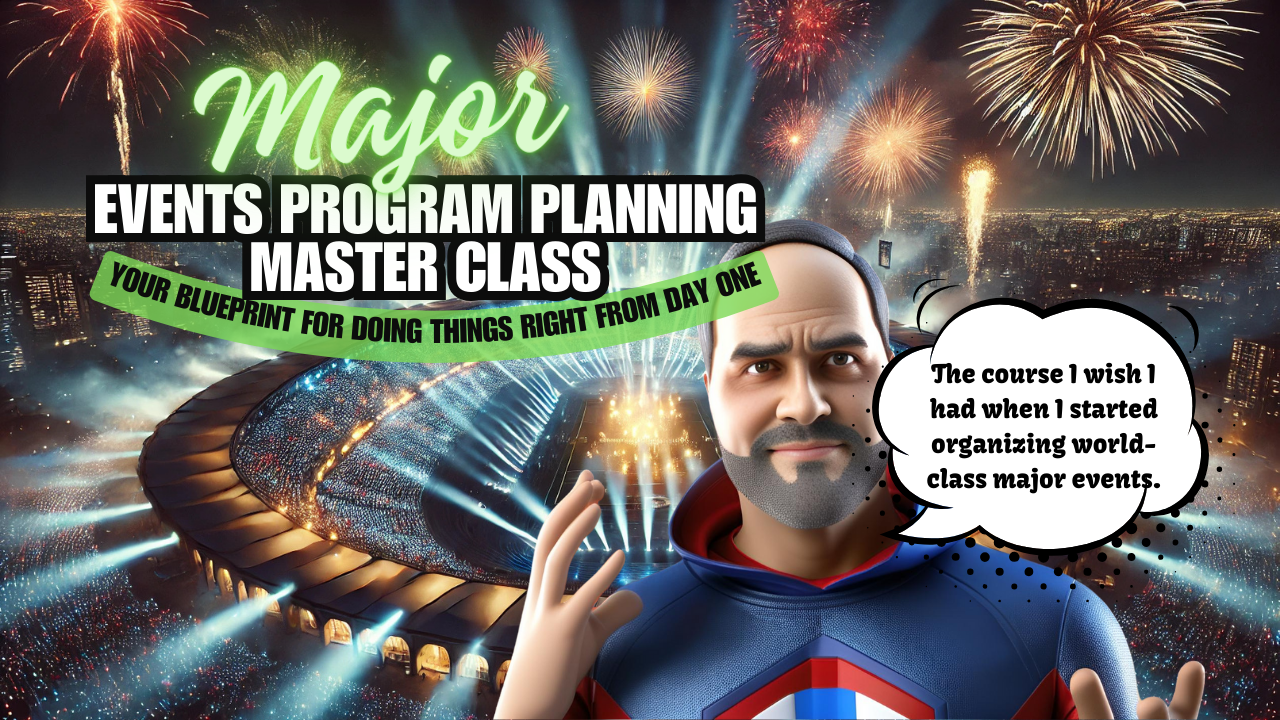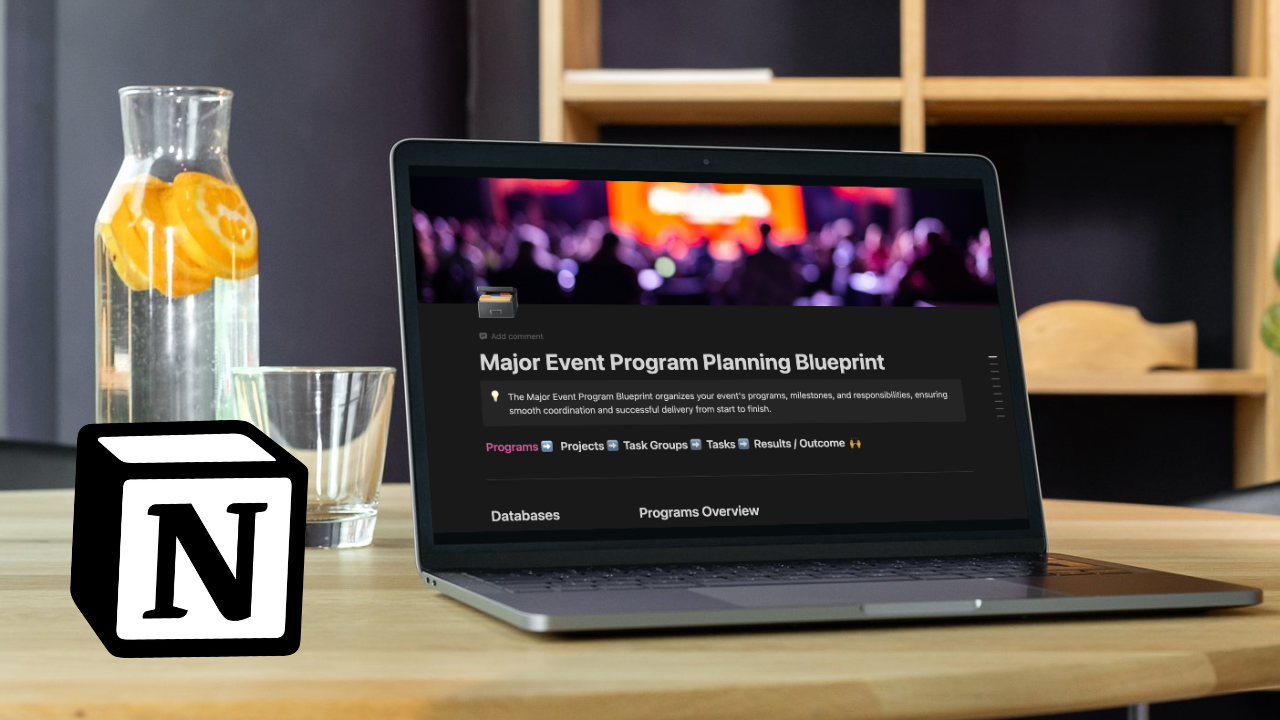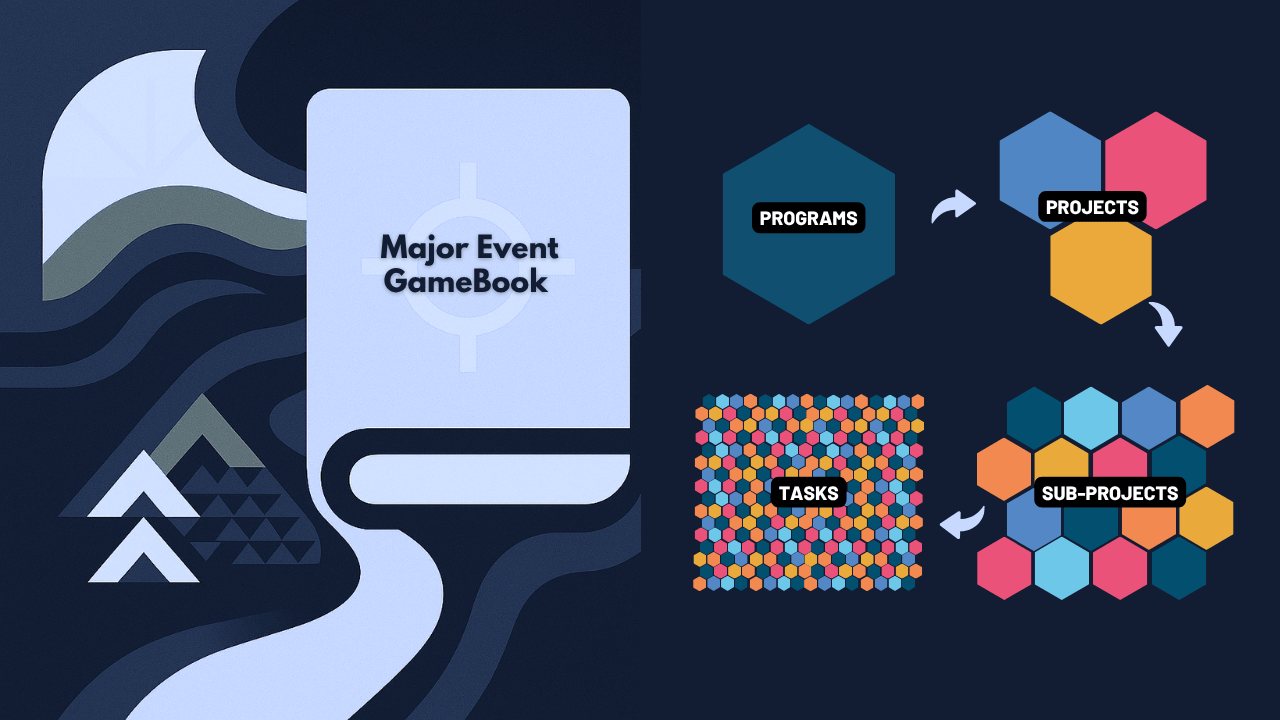
Major Event Program Planning blueprint
One master file. Dozens of programs. Hundreds of projects. One clear line from idea to delivery.
The Major Event Program Blueprint ties your strategy and organising responsibilities to real delivery. One framework — clear programs, concrete projects, deadlines, owners, budgets. It gives you the full picture to lead your major event from first actions to final wrap-up.
The Cost of No major event program Blueprint
Major events are some of the most complex projects on earth.
I’ve been there - and I have a feeling, that you know this too.
You know, we have easily 40 000 tasks to complete in organising work - before we are finished. Along with pressure, opinions, and a deadline that doesn’t care.
I’ve seen organisers to take this journey with all kinds of playbooks.
Most teams improvise. Some survive. A few get it right.
Backed by 20+ years experience of major events I have come up with practical major event program planning blueprint — that reveals what those few do.
Now availble for anyone.
by Jesse Kiuru, Eventpreneur
10 Principles of major event program planning
-
Every program, project, sub-project, and task must answer this first: why.
Why this program (or project) matters to us?
If the purpose is clear, every decision ties back to the big goal.
No wasted actions. No drifting.
Just work that fits the vision and mission.
-
Every program, project, task group, and task starts with knowing who it’s for.
Athletes and teams competing at the highest level.
Coaches making sure performance stays at peak.
Officials enforcing fair play and rules.
Journalists reporting. Broadcasters delivering coverage. Content creators sharing the story.
Live audiences in stadiums. Virtual viewers on streams. Fans following from anywhere.
Sponsors funding. Commercial partners activating. Suppliers keeping logistics smooth.
Governments. Sports federations. Governing bodies.
Event workforce. Local Organising Committee. Contractors.
VIPs. Dignitaries. Celebrities.
Residents. Local businesses. Cultural groups.Observers. Knowledge transfer teams.
Every plan and action needs to know its audience. No guesswork.
-
Plans don’t run events. People do.
From top to ground, every layer has its part.Leadership: Governing Board, CEO, Event Director — set direction, guard the vision, approve big calls.
Management: Chief Event, Operating, Commercial, Marketing, Finance — turn strategy into plans, keep operations tight.
Event Organisation: Functional teams and workforce — logistics, hospitality, media ops, accreditation, daily tasks, on-ground delivery.
Stakeholders: Federations, government agencies, regulators — oversight, support, legitimacy.
Partners: Sponsors, service providers, suppliers — funding, tech, catering, branding, activation.
Planning means nothing if no one owns the doing.
This structure keeps it clear — who plans, who runs, who finishes.
-
One system, four layers.
This is the core of my framework of Major Event Program Planning.
Programs: The big picture — each covers a major area. Expect to list 30~40 for a major event.
Projects: Break programs into clear goals — ~10+ per program.
Task Groups = Sub-Projects: Split projects again — special focus areas, ~10 per project.
Tasks: The smallest steps — plan, produce, deliver. Clear tasks mean smooth execution.
No loose ends. No hidden gaps.
From top program to last task — all work mapped and delegated on right level.
-
Every major event needs three basic investments:
time, money, effort.
On operational level thinking resources by this 4S Framework is super clear:
Space — stadiums, arenas, public areas, transport hubs. They must be safe, ready, fit for purpose.
Stuff — equipment, furniture, tech systems, supplies. Every physical and digital piece in place.
Staff — leadership, teams, volunteers, specialists. Trained, motivated, in the right roles.
Services — sponsors, suppliers, contractors. Outside expertise and extra hands when needed.
When you see all four, you know what it really takes to deliver your tasks.
-
Every program, project, task group, and task is built on four sources.
Must-Haves — the non-negotiables. Hosting agreements, competition rules, laws, safety standards, funding contracts. The legal and technical backbone.
Wants/Needs — the strategic drivers. Vision, strategy, event concept, business model, customer experience, marketing, legacy plan. These shape the bigger story.
Nice-to-Haves — the extras. Local culture, innovation, fan ideas, special side events, pilots. These lift the experience above the basics.
Won’ts — what not to do. Overcommit on extras and miss the core. Ignore rules. Promise what resources can’t cover. Bend to late changes without thinking through the chain.
Every line in the plan belong to some of these.
And. This is the way you prioritise your doing.
-
Every program, project, and task follows the same chain.
Idea: Why are we doing this? Align work with a clear purpose.
Input: What do we need? Lock the right people, tools, and resources.
Output: What do we deliver? Define what gets done — tangibles only.
Outcome: What’s the immediate impact? Know the direct effect of each result.
Value: What’s the long-term benefit? Connect the work to bigger goals and legacy.
WHY → WHAT → HOW → SO WHAT → THEN WHAT?
If you skip steps, you lose the link from effort to real value.
-
Clear metrics keep everyone honest — and on track.
KPIs run through every layer:
Programs use strategic KPIs.
Projects use deliverable-focused KPIs.
Task Groups track activity-level KPIs.
Tasks measure action-based KPIs.
For each project and sub-project, track what matters most.
Progress, gaps, what’s done, what’s late — so you steer before problems steer you.
-
Not everything runs at once. Knowing the right phase saves time, cost, and stress.
Every major event project follows these phases:
Bidding — secure the rights.
Master Planning — set goals, strategies, concept.
Event Planning — detail the operations.
Preparation — arrange the practical groundwork.
Implementation — build, set up, get ready.
Delivery — live days, run the event.
Wrap-Up — evaluate, adjust, close files.
Legacy — keep the long-term benefit alive.
A master timeline shows what lands when — but phases make it real.
-
Every program, project, task group, and task should tie back to clear results.
Five keys sum it up:
Revenue — ticket sales, partnerships, merchandising, solid budgets.
Impacts — social, environmental, cultural. Local workforce, sustainability, local stories.
Vision & Goals — business targets, audience value, reputation, visibility.
Legacy — knowledge transfer, repeatable systems, stronger future partnerships, better infrastructure.
Stakeholder Benefits — sponsor visibility, delivered activations, trust for the next deal.
If it doesn’t lead to at least one of these, it’s probably not worth doing.
Practical Guides, MasterMinds and Templates for Major Event Program Planning
-

Master Class: Major Event Program Planning
Learn how top event teams structure and run every program and project — step by step. 11 Sessions starts in January, 1st 2026. Price 1495 € (+VAT)
-

Full Program Planning Guide for Major Events (100+ pages)
A full planning structure for how major events actually get delivered — across programs, projects, sub-projects, and tasks.
-

Program Planning Notion Template
Start your full plan in Notion — build your structure without staring at a blank page. Purchase this via my Gumroad account.
-

Google Sheet: Master Planning Template
One master file pre-filled template for major sports events — programs, projects, all mapped out. Includes 35+ tables with example content to boost your productivity.
-

Cheat Sheet for Major Event Programs
Cheatlist: Full Program Menu. Complete pick-list of programs that are relevant in most major events. Don’t start the work from blank page.
-

CHEAT SHEET FOR MASTER PLANNING TASKING
67 must-do tasks to lock your event’s vision, scope, risk plans and basics before detailed work starts. Get the big pieces clear, then plan the details right. This helps you start.
-

CHEAT SHEET FOR EVENT PLANNING TASKING
167 tasks covering logistics, operations, people and partners. Keeps your planning phase organised, so every promise connects to real steps. Don’t start with blank page.
-

CHEAT SHEET FOR EVENT DELIVERY TASKING
Key tasks for live event days — monitor progress, fix gaps, keep teams aligned and operations tight when it matters most. One sheet, not to start from scratch.
-

MAJOR EVENT MASTER TIMELINE PLANNER TEMPLATE
Organize and track your event’s key milestones, programs, and timelines across multiple years and phases. This essential tool provides a frame for quarter-to-quarter and month-to-month timelines to ensure your event runs smoothly and all critical tasks are completed on time.
-

Sweep File: Program Planning Bundle
Swipe Folder of 15 PDFs, visual and breakdown in one grab — your full quick guides of Major Event Program Planning for reference and team sharing.
Support for Building Your Major Event Program & Project Plan
The Program Planning Framework is exactly what I wish I’d had when I was running the FIS Nordic World Ski Championships 2017 as Event Director — and later as Secretary General for the Lahti Ski Games. Back then, we built parts of this by trial and error. Now it’s here, tested and ready to use.
I help you keep your program and project plans clear, realistic, and alive when the real work starts. Not slides that collect dust.
Here’s how I help you keep it sharp and practical:
✅ The Major Event Program Blueprint Template — the full structure in one ready-to-use file. Programs, projects, task groups, tasks — all mapped and linked.
✅ Individual Sheets & Guides — checklists, breakdowns, and editable templates for each piece: responsibilities, phases, KPIs, budget rows.
✅ Program Planning Sprint — nail your full program and project plan in one focused session, with my help to break complexity into clear steps.
✅ 1:1 Support & Reviews — tighten what you have, fix what’s missing, or run through your full plan to check that it works for real delivery.

